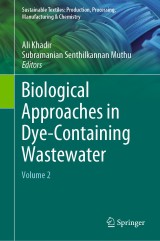Details

Biological Approaches in Dye-Containing Wastewater
Volume 2Sustainable Textiles: Production, Processing, Manufacturing & Chemistry
|
96,29 € |
|
| Verlag: | Springer |
| Format: | |
| Veröffentl.: | 28.03.2022 |
| ISBN/EAN: | 9789811905261 |
| Sprache: | englisch |
Dieses eBook enthält ein Wasserzeichen.
Beschreibungen
<p>This Volume 2 contains essential contributions highlighting the use of biotechnology in dye removal. It begins with an overview of activated sludge process for dye removal along with its limitation is carried out and describes the fundamental concepts of dye-containing textile wastewater treatments, particularly microbial and enzymatic approaches, including the most usual textile wastewater treatments and their trends. It discusses the role microbial biofilms play when employed in the integrated treatment system for effective detoxification, degradation and complete mineralization of pollutants in dye waste effluents. It assesses the most recent advances in the biotransformation of synthetic dyes from wastewater, especially anthraquinone-typed dyes. Phycoremediation as an emerging and efficient technology in dye removal, remediation strategies used by microalgae, and the role of fungi in the dye removal are presented.</p>
Dye removal using activated sludge.- Fundamental concepts of dye-containing textile wastewater treatments: microbial and enzymatic approaches.- Role of microbial biofilms in dye degradation during textile wastewater treatment.- Biotransformation of anthraquinone dye by microbial enzymes.- Microalgae-Based Remediation Approaches in Textile Dye Removal.- Plant–Microbe-Based Remediation Approaches in Dye Removal.- Role of fungi in the removal of synthetic dyes from textile industry effluents.- The Applicability of the Microalgae-Based Systems in Textile Dye Industrial Wastewater.- Potential for Constructed Wetlands Aimed at Sustainable Wastewater Treatment, Reuse, and Disposal in Dyestuff and Textile Sectors.<p></p>
<p><b>Ali Khadir</b> is an environmental engineer and a member of the Young Researcher and Elite Club, Islamic Azad University of Shahre Rey Branch, Tehran, Iran. He has published several articles and book chapters in reputed international publishers, including Elsevier, Springer, Taylor & Francis, and Wiley. His articles have been published in journals with IF of greater than 4, including Journal of Environmental Chemical Engineering and International Journal of Biological Macromolecules. He also has been the reviewer of journals and international conferences. His research interests center on emerging pollutants, dyes, and pharmaceuticals in aquatic media, advanced water and wastewater remediation techniques and technology. </p>
<p><b>Dr. Subramanian Senthilkannan Muthu</b> currently works for SgT Group as Head of Sustainability, and is based out of Hong Kong. He earned his PhD from The Hong Kong Polytechnic University, and is a renowned expert in the areas of Environmental Sustainability in Textiles & Clothing Supply Chain, Product Life Cycle Assessment (LCA) and Product Carbon Footprint Assessment (PCF) in various industrial sectors. He has five years of industrial experience in textile manufacturing, research and development and textile testing and over a decade's of experience in life cycle assessment (LCA), carbon and ecological footprints assessment of various consumer products. He has published more than 100 research publications, written numerous book chapters and authored/edited over 100 books in the areas of Carbon Footprint, Recycling, Environmental Assessment and Environmental Sustainability.</p>
<p><b>Dr. Subramanian Senthilkannan Muthu</b> currently works for SgT Group as Head of Sustainability, and is based out of Hong Kong. He earned his PhD from The Hong Kong Polytechnic University, and is a renowned expert in the areas of Environmental Sustainability in Textiles & Clothing Supply Chain, Product Life Cycle Assessment (LCA) and Product Carbon Footprint Assessment (PCF) in various industrial sectors. He has five years of industrial experience in textile manufacturing, research and development and textile testing and over a decade's of experience in life cycle assessment (LCA), carbon and ecological footprints assessment of various consumer products. He has published more than 100 research publications, written numerous book chapters and authored/edited over 100 books in the areas of Carbon Footprint, Recycling, Environmental Assessment and Environmental Sustainability.</p>
This Volume 2 contains essential contributions highlighting the use of biotechnology in dye removal. It begins with an overview of activated sludge process for dye removal along with its limitation is carried out and describes the fundamental concepts of dye-containing textile wastewater treatments, particularly microbial and enzymatic approaches, including the most usual textile wastewater treatments and their trends. It discusses the role microbial biofilms play when employed in the integrated treatment system for effective detoxification, degradation and complete mineralization of pollutants in dye waste effluents. It assesses the most recent advances in the biotransformation of synthetic dyes from wastewater, especially anthraquinone-typed dyes. Phycoremediation as an emerging and efficient technology in dye removal, remediation strategies used by microalgae, and the role of fungi in the dye removal are presented.<p></p>
Highlights important recent advancements in various biological treatment systems toward dye removal and degradation Presents advantages and limitation of common biological wastewater treatment methods Includes comprehensive reviews of plant–microbe-based remediation approaches

















